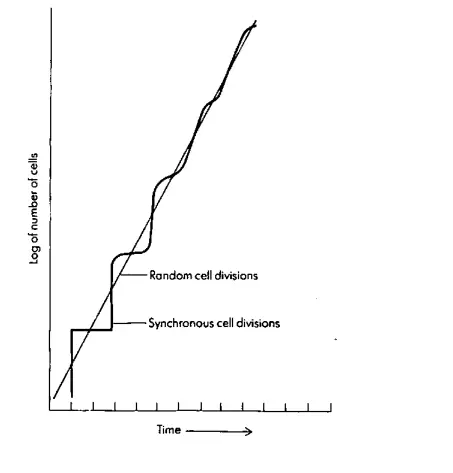Synchronous culture Definition
A synchronous or synchronized culture is a microbiological culture or a cell culture which contains the cells that are all in the same growth stage.
- The Synchronous culture also known as the synchronous growth.
- The synchronous growth of a bacterial culture means all the cells of the culture remain at the same stage of growth and they grow all together from one phase to another.
- A population can be synchronized by manipulating their physical environments or physical composition of the medium.
- If we keep an organism under unfavourable conditions there they will metabolize very slowly, but will not divide. If we keep the organisms under favourable conditions, then all cells undergo division and stay at the same phase.
- The cells of the synchronously growing culture divide at a time, their growth curve forms a Zig Zag pattern.
- The easiest way to synchronize bacterial growth is to add some cytostatic agents so that cells don’t divide and they all maintain the same state of metabolism and cell cycle. When the cytostatic agent is removed, all cells start to divide at the same time.
- Synchronous culture/Synchronous growth of bacteria consists of two phases such as stationary phase and exponential phase.

Obtaining Synchronous culture
There are present different method for obtaining a Synchronous culture such as;
- To arrest the growth of all cells in the culture, alter the External conditions, and then again alter the conditions to continue the growth. As a result of this, all the fresh growing cells are now beginning to grow at the same stage, and they are synchronized.
- Synchronous culture can be obtained by eliminating the essential nutrient from the growth medium and later re-introduce it.
- The chemical growth inhibitors can be used to stop cell growth. When the growth is completely stopped for all cells, then remove the inhibitor from the culture and the cells will begin to grow synchronously. For example, Nocodazole is used in biological research for synchronization.
- Cells in various growth stages contain distinct physical properties. Cells in culture can thus be physically divided depending on their density or size, for instance. This can be done by using centrifugation (for density) or filtration (for size).
- The Helmstetter-Cummings technique can be used to obtain a Synchronous culture. In this method, the bacterial culture is passed through a membrane. Some of these cells will remain bound to the membrane. After that a fresh medium is added to the membrane, as result, the membrane-bound bacteria will start to grow. Fresh bacteria that separated from the membrane are now all at the identical stage of growth; they are accumulated in a flask that now harbors as a synchronous culture.
Application of Synchronous culture
- Synchronous culture helps in the separation of the smallest cells from an exponentially growing culture.
- In the laboratory it is used to study the cell cycle.
- Important in the study of genetics and metabolism.
References
- https://www.slideshare.net/SivaSss1/bacterial-growth-diauxic-growthsynchronous-growth-and-continuous-growth
- https://en.wikipedia.org/wiki/Synchronous_culture
- https://www.mybiosource.com/learn/testing-procedures/synchronous-cultures-micro-organisms/
- Text Highlighting: Select any text in the post content to highlight it
- Text Annotation: Select text and add comments with annotations
- Comment Management: Edit or delete your own comments
- Highlight Management: Remove your own highlights
How to use: Simply select any text in the post content above, and you'll see annotation options. Login here or create an account to get started.